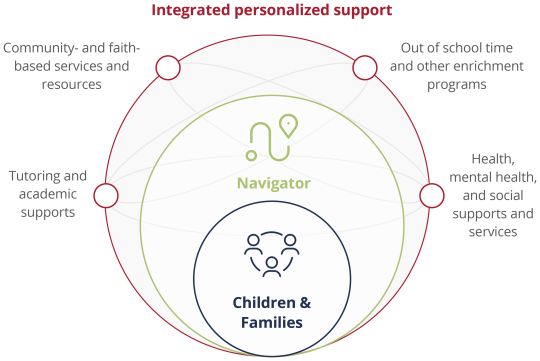Our Work
EdRedesign provides catalytic support to the cradle-to-career place-based partnership field to drive systems-level change and open personalized pathways to opportunity.
The landscape of opportunities for children, youth, and families is vastly inequitable throughout our nation, in every region and state, from city to city and neighborhood to neighborhood. Factors outside of school, including structural racism and economic inequity, explain much of the variance in well-being, educational attainment, and upward mobility, yet efforts to achieve equity for children and youth have largely focused on changing what happens in school despite the fact that school-age children spend 80% of their time outside of school. To change the status quo, we need strategies that go beyond schools to ensure that all children and youth thrive. We are advancing a new paradigm for child and youth development and education.
We believe strategies to expand opportunities for children and youth have two critical components: place-based, cross-sector collaboration to remove structural barriers and open pathways to opportunity; and personalized, relationship-based supports, what we call Success Planning, for children and youth to reach their full potential.

Place-based cross-sector collaboration amplifies the impact of local governmental and non-governmental systems and programs serving children. Communities need to work together, across sectors, to create coordinated systems of support and opportunity for children and youth through Children’s Cabinets or other cross-sector community backbone organizations and cradle-to-career place-based partnerships.

Supports and opportunities need to be personalized to meet the needs of each individual child through what we call Success Planning. Success Planning is a relationship-based approach that connects each child or youth to an adult Navigator who co-creates a personalized plan for action in partnership with their families and other caring adults. The plan highlights the child’s needs and strengths and identifies supports, enrichments, and other resources to remove barriers, help them thrive, and support their goals. Through a whole-child approach, Success Planning provides a mechanism to ensure every child is known, seen, and heard, has a positive connection to a caring adult, and has agency over their pathway to success.

When taken together, cross-sector collaboration and Success Planning, allow communities to:
- Meet children where they are and give them what they need;
- Provide services and resources more effectively and efficiently; and
- Utilize data in real-time to identify gaps, measure impact, and continuously improve policy, practice, and collective impact work at scale.
Communities that engage in both cross-sector collaborative action and Success Planning are pairing two powerful approaches that will fortify local ecosystems and increase access, leading to significant positive changes in policy, practice, and school and life outcomes for children, youth, and families.
To support this growing field to drive transformational, systems-level change that serves the needs and talents of individual children and youth, our work focuses on talent development, our Institute for Success Planning, our By All Means initiatives, and actionable research.
